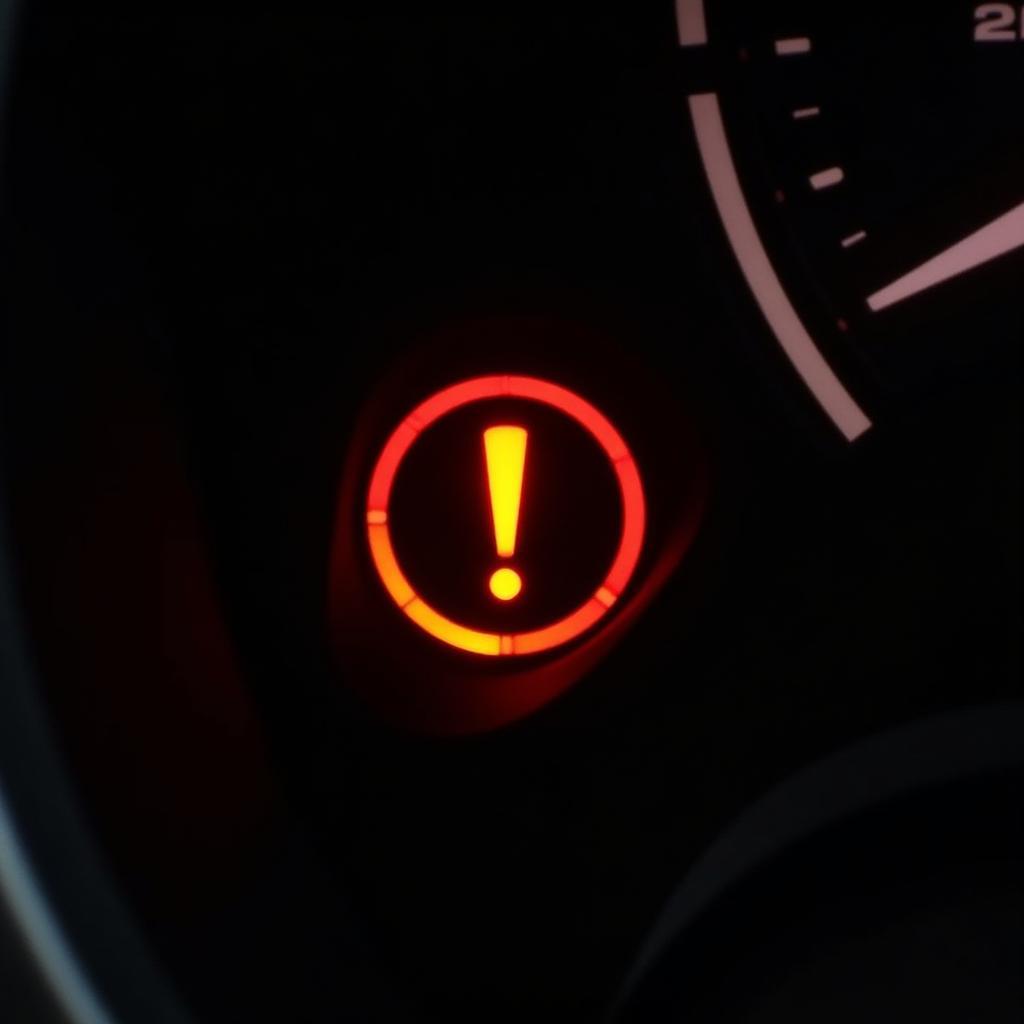The brake warning light, a prominent signal on your dashboard, illuminates for several reasons, most of which warrant immediate attention. While it might seem straightforward, understanding why this light is on is crucial for your safety and the longevity of your vehicle. This article will guide you through the various reasons your brake warning light might be on and what steps to take when you see it illuminated.
 Brake Warning Light on Dashboard
Brake Warning Light on Dashboard
Common Reasons Your Brake Warning Light is On
There are several reasons why your brake warning light might turn on, ranging from simple fixes to more serious issues:
1. Engaged Parking Brake
One of the most common and benign reasons for the brake warning light to illuminate is an engaged parking brake. This is often overlooked, especially by new drivers. Before panicking, ensure your parking brake is fully disengaged.
2. Low Brake Fluid Level
Your brake system operates on hydraulic pressure provided by brake fluid. If the fluid level drops too low, the warning light will activate. Low brake fluid can indicate a leak in the system, which needs immediate professional attention.
3. Worn Brake Pads
Brake pads are designed to wear down over time. Most vehicles have wear indicators built into the brake pads that trigger the warning light when the pads reach a critical thickness. Ignoring this warning can lead to further damage and compromised braking ability.
what does the brake warning light mean ford taurus 2003
4. Brake System Malfunction
A malfunctioning component within the brake system, such as a faulty ABS sensor or a problem with the master cylinder, can trigger the warning light. These issues require a more in-depth diagnosis using specialized tools often found at a mechanic’s workshop.
“Modern cars heavily rely on sensors and electronic control units to manage braking systems,” says John Miller, a veteran automotive engineer. “Any fault within these systems can trigger the warning light, urging the driver to seek professional diagnosis.”
5. Brake Light Issues
In some vehicles, the brake warning light might illuminate if there’s an issue with the brake lights themselves, such as a blown bulb. This connection ensures you are aware of any problems affecting the functionality of your brake lights, which are crucial for signaling to other drivers.
porsche brake pad wear warning light
What to Do When the Brake Warning Light Comes On
Seeing the brake warning light come on can be unnerving, but remaining calm is crucial. Here’s a step-by-step guide on what to do:
-
Safely pull over: As soon as it’s safe, pull over to the side of the road or a safe location. Avoid heavy traffic areas.
-
Check your parking brake: Ensure the parking brake is fully disengaged.
-
Check your brake fluid level: If you feel comfortable and it’s safe to do so, carefully check the brake fluid level in the reservoir. If it’s low, adding brake fluid might temporarily address the issue, but it’s crucial to get it checked for leaks by a professional.
-
Do not continue driving if:
- You suspect a brake fluid leak.
- You experience any changes in braking performance, such as a soft brake pedal, grinding noises, or the vehicle pulling to one side when braking.
- The warning light remains illuminated even after checking the parking brake and brake fluid level.
-
Call for roadside assistance or tow your vehicle to a mechanic: If you suspect any serious issue with your braking system, it’s safest to avoid driving altogether.
yellow brake fluid warning light on 1983 mercedes 300d
Brake Warning Light: Better Safe Than Sorry
Remember, the brake warning light is a critical safety feature in your vehicle. Ignoring it could lead to serious accidents and costly repairs.
“Preventive maintenance is key for a healthy brake system,” advises Miller. “Regular brake inspections and timely replacement of worn parts can prevent unexpected issues and keep you safe on the road.”
bmw 3 series brake fluid warning light
2016 audi q5 brake pad warning light
FAQs about the Brake Warning Light
1. Can I drive with the brake warning light on?
It’s generally unsafe to drive with the brake warning light on. While a simple issue like an engaged parking brake might be the cause, other reasons, such as low brake fluid or a system malfunction, necessitate immediate attention and could be dangerous to ignore.
2. How much does it cost to fix a brake warning light issue?
The cost of fixing a brake warning light issue varies greatly depending on the underlying cause. Simple fixes, such as topping up brake fluid or replacing a blown brake light bulb, can be relatively inexpensive. However, more complex problems, such as repairing a brake line leak or replacing major brake components, can be significantly more costly.
3. How often should I check my brake fluid?
It’s a good practice to visually inspect your brake fluid level at least once a month. Look for the brake fluid reservoir under the hood and check if the fluid level falls between the minimum and maximum marks.
4. Can I add brake fluid myself?
While you can add brake fluid yourself, it’s crucial to use the correct type of fluid specified in your vehicle’s owner’s manual. If you’re uncomfortable adding brake fluid yourself, it’s best to have a mechanic do it for you.
5. What color is the brake warning light?
The brake warning light is typically red, indicating a potentially serious issue requiring immediate attention. In some vehicles, it might be yellow, suggesting a less critical issue like worn brake pads.
